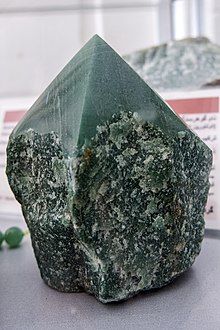Aventurine quartz
Aventurine also Aventurine , mica quartz or shortly aventurin ( Avanturin ) called, is a variety of the mineral quartz with microcrystalline inclusions of fuchsite , mica or hematite , which cause a strong glitter that by this variety as Aventureszenz is referred to.
Whether aventurine quartz is counted among the minerals or the rocks is a question of definition. It is traditionally considered to be a mineral.
Etymology and history
The abbreviation aventurine originally only applied to the quartz variety. However, since a similar-looking variety of oligoclase (feldspar) was also called aventurine, this name is now misleading. Therefore, the original mineral is also mentioned to differentiate.
In Murano near Venice , at the beginning of the 18th century , a red-gold shimmering, opaque glass was produced by chance (Italian: a ventura ) and in a secret manner , after which the similar-looking quartz variety was named. The artificial product, although softer but of a much more beautiful appearance than the natural one, was preferred.
At the end of the 19th century, Friedrich Wöhler and Max von Pettenkofer developed a process with which aventurine glass similar to the old Venetian can be made. The flickers in the glass flux colored by iron consist of metallic copper , which is dispersed in the molten mass in its crystal planes. The copper is added to the glassware as copper (I) oxide and is reduced to metal in the same . The glass is processed into fake jewelry, shirt buttons, bracelets, etc.
By rolling mica flakes into the glass mass, masses are created, which are then blown or poured into objects that are also called aventurine glass.
Green Aventuringlas was first in 1865 by the French chemist Pelouze made and since then in increasing quantities in the French factories imitation goods processed.
Here, the glass is given an addition of chromium (in the form of potassium dichromate) as an essential component ; When it melts, chromium oxide is formed , which is also vitrified and colors the glass green, which has long been known. The special effect is achieved by introducing more chrome than can be vitrified; the excess then crystallizes in glossy black-brown crystals and the mass takes on a very nice appearance. In the case of paintwork with a similar appearance, one speaks of aventurine paint ; these are mainly made in Japan .
Color varieties
- gold-red to brown-red aventurine quartz - mica or hematite flakes; is often confused with aventurine feldspar (sunstone)
- green aventurine quartz - enclosed fuchsite flakes
- blue aventurine quartz - enclosed crocidolite - or rutile fibers
Education and Locations
Aventurine is found in large quantities in the Urals , in Germany, on the other hand, only at a few sites near Aschaffenburg and Johanngeorgenstadt , in Austria near Mariazell and also near Belany in India .
Use as a gem stone
Aventurine quartz is used almost exclusively as a gemstone , preferably in pearl necklaces , solid bracelets , finger rings , earrings or tumbled stones , as these round, cabochon- like shapes particularly emphasize the shimmering sheen of the stone. But this material was also used in the manufacture of smaller and larger art objects such as vases , table tops , boxes and others.
In addition to aventurine feldspar, jade and nephrite are also visually similar to aventurine quartz and can be confused with it.
Esoteric
In esotericism , aventurine quartz is used as a healing stone . Among other things, it should help against eczema, allergies, blemished skin (acne) and hair loss and alleviate eye diseases. It should also promote the suppleness of the mind and give inner peace and serenity. There is no scientific evidence for this.
See also
literature
- Petr Korbel, Milan Novák: Encyclopedia of Minerals . Nebel Verlag GmbH, Eggolsheim 2002, ISBN 3-89555-076-0 .
- Walter Schumann: Precious stones and gemstones . 13th edition. BLV, Munich 2002, ISBN 3-405-16332-3 .
- Bernhard Bruder: Beautified stones . Neue Erde Verlag, 1998, ISBN 3-89060-025-5 .


